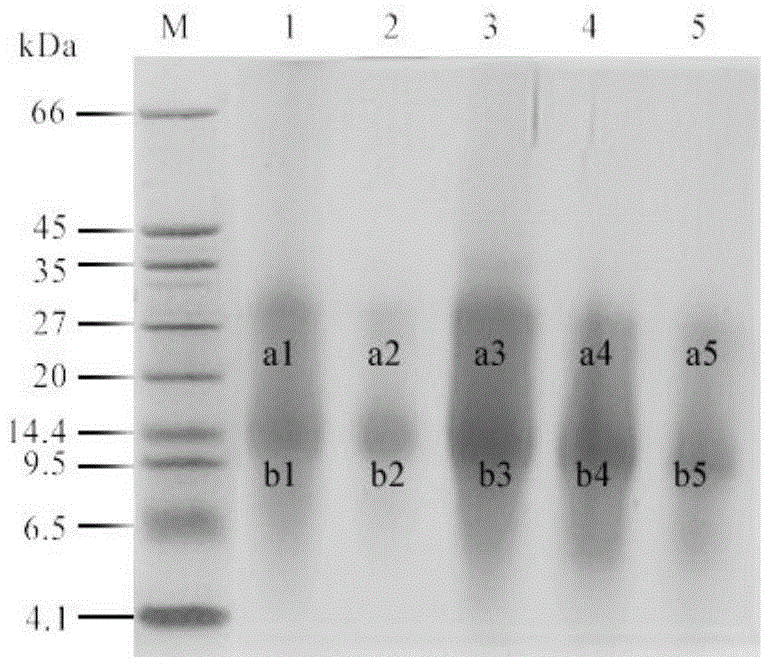Evaluation method of specificity removal effect of haze sensitive protein in yellow wine
A sensitive protein and evaluation method technology, applied in the direction of measuring devices, instruments, scientific instruments, etc., can solve the problems of arbitrary judgment methods, randomness of time and temperature, and lack of
- Summary
- Abstract
- Description
- Claims
- Application Information
AI Technical Summary
Problems solved by technology
Method used
Image
Examples
Embodiment 1
[0031] (1) Tannin treated samples
[0032] First prepare tannin into 1% tannin solution, then add tannin solution to the wine sample to be clarified to make the final tannin concentration reach 70mg / L, stir and mix well, after standing for five days, take the supernatant and filter, fill . Collect the lower precipitate, dissolve it with 2% ammonia water, slowly add ammonium sulfate to make the relative saturation reach 80%, mix and stir to form a precipitate, collect the precipitate by centrifugation, dialyze for desalting, and freeze-dry to obtain a tannin-adsorbed protein sample.
[0033] (2) Collection of turbidity-sensitive proteins
[0034] Wine samples without tannins were stored naturally for a period of time until turbid precipitation appeared, and the sediment was collected by centrifugation, then suspended in ultrapure water, centrifuged, and the above process was repeated, the precipitation was collected, washed twice with ultrapure water, and washed twice with 2 ...
Embodiment 2
[0045] (1) Add silica gel No. 1 and No. 2 to the wine sample to be clarified, so that the final silica gel concentration reaches 500 mg / L, stir and mix well, and after standing for 1 hour, take the supernatant to filter and fill. The lower layer of silica gel was collected, the silica gel adsorbed protein was eluted with 2% ammonia water, and the silica gel was removed by centrifugation. Slowly add ammonium sulfate to the supernatant to make the relative saturation reach 80%, mix and stir to form a precipitate, collect the precipitate by centrifugation, desalt by dialysis, and freeze-dry to obtain silica gel 1 and 2 adsorption protein samples. The silica gel No. 1 refers to A100 silica gel purchased from PQ Company of the United States, and the silica gel No. 2 refers to dry silica gel purchased from Stabifix Company of Germany.
[0046] (2) Turbidity-sensitive protein collection, Tricine-SDS-PAGE, MALDI-TOF / TOF MS reference example 1
[0047] (3) After the molecular weight d...
Embodiment 3
[0050] Adding Polyclar to wine samples to be clarified R Brewbrite, making the final Polyclar R When the concentration of Brewbrite reaches 200mg / L, stir and mix well. After standing still for 1 hour, take the supernatant to filter and fill. Collect the lower precipitate, elute the adsorbed protein with 2% ammonia water, and centrifuge to remove Polyclar R Brewbrite. Slowly add ammonium sulfate to the supernatant to make the relative saturation reach 80%, mix and stir to form a precipitate, collect the precipitate by centrifugation, dialyze for desalination, freeze-dry to obtain Polyclar R Brewbrite adsorbs protein samples. The Polyclar R Brewbrite was purchased from American International Specialty Company.
[0051] (2) Turbidity-sensitive protein collection, Tricine-SDS-PAGE, MALDI-TOF / TOF MS reference example 1.
[0052] (3) After analysis of molecular weight distribution by Tricine-SDS-PAGE and identification by MALDI-TOF / TOF MS, Polyclar R Brewbrite-adsorbed ...
PUM
| Property | Measurement | Unit |
|---|---|---|
| Molecular weight | aaaaa | aaaaa |
Abstract
Description
Claims
Application Information
 Login to View More
Login to View More - R&D
- Intellectual Property
- Life Sciences
- Materials
- Tech Scout
- Unparalleled Data Quality
- Higher Quality Content
- 60% Fewer Hallucinations
Browse by: Latest US Patents, China's latest patents, Technical Efficacy Thesaurus, Application Domain, Technology Topic, Popular Technical Reports.
© 2025 PatSnap. All rights reserved.Legal|Privacy policy|Modern Slavery Act Transparency Statement|Sitemap|About US| Contact US: help@patsnap.com



